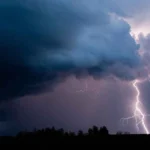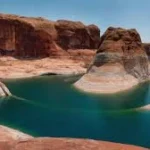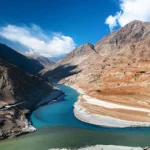
Nestled in the heart of the American Southwest, Antelope Canyon is a breathtaking natural wonder that draws visitors from around the globe. Renowned for its stunning sandstone formations and mesmerizing light beams that dance through the narrow passages, this iconic slot canyon offers a unique glimpse into the geological and cultural history of the region. Whether you’re an avid photographer seeking the perfect shot or a nature enthusiast eager to explore its hidden beauty, Antelope Canyon has something for everyone. In this blog, we will delve into 25 fascinating facts about Antelope Canyon, uncovering its accessibility, safety measures, and conservation efforts, as well as tips for making the most of your visit. Join us on this journey to discover what makes Antelope Canyon a must-see destination!
Location: Antelope Canyon is situated in the Navajo Nation, which is a vast area covering parts of Arizona, Utah, and New Mexico. Specifically, it is located near Page, Arizona, a small city that serves as a gateway to various natural attractions. The canyon’s location within the Navajo Nation adds a layer of cultural significance, as it is a site deeply intertwined with the history and traditions of the Navajo people.
Type: Antelope Canyon is classified as a slot canyon, a type of canyon characterized by its narrow, deep passageways formed through the erosive power of water. Slot canyons typically have high walls that tower above the canyon floor, creating a dramatic and visually stunning environment. The narrowness of the passages often leads to unique lighting conditions, where sunlight filters through the openings above, illuminating the walls with vibrant colors.
Formation: The formation of Antelope Canyon is a result of natural processes that have taken place over thousands of years. It was primarily shaped by the forces of flash flooding, which can occur suddenly in the desert environment. As water rushes through the canyon, it erodes the sandstone, carving out the smooth, flowing shapes that are characteristic of the canyon’s walls. This process is ongoing, as the canyon continues to be shaped by the elements.
Two Sections: Antelope Canyon is divided into two main sections: Upper Antelope Canyon and Lower Antelope Canyon. Each section offers a distinct experience for visitors. Upper Antelope Canyon is wider and more accessible, making it a favorite among photographers and tourists. In contrast, Lower Antelope Canyon features narrower passageways and requires visitors to navigate ladders and stairways, providing a more adventurous exploration.
Upper Antelope Canyon: Known for its breathtaking beauty, Upper Antelope Canyon features wider passageways that allow for easier navigation. This section is particularly famous for its stunning light beams that penetrate the canyon during the midday sun, creating a magical atmosphere. The walls of Upper Antelope Canyon are smooth and undulating, and the interplay of light and shadow enhances the rich colors of the sandstone, making it a popular spot for photography.
Lower Antelope Canyon: Lower Antelope Canyon offers a different experience with its narrower and more intricate passages. Visitors must descend ladders to explore this section, which adds an element of physical engagement to the tour. The walls of Lower Antelope Canyon are equally stunning, with swirling shapes and vibrant colors. The unique geological formations create a sense of wonder as visitors navigate through the winding corridors.
Navajo Name: The Navajo name for Upper Antelope Canyon is “Tsé bighánílíní,” which translates to “the place where water runs through rocks.” This name reflects the canyon’s formation process and its significance to the Navajo people. The canyon is not only a natural wonder but also a cultural landmark, symbolizing the relationship between the Navajo people and their environment.
Photography: Antelope Canyon is renowned for its photographic opportunities, particularly due to the light beams that shine down into the canyon during certain times of the day. These beams are most prominent in the summer months when the sun is high in the sky. Photographers flock to the canyon to capture the ethereal quality of the light and the rich colors of the sandstone, making it one of the most photographed slot canyons in the world.
Best Time for Photos: For photographers aiming to capture the iconic light beams, the best time to visit Antelope Canyon is between 11 AM and 1:30 PM. During these hours, the sunlight angles perfectly to create the striking beams that filter into the narrow canyon. This phenomenon occurs primarily in Upper Antelope Canyon, where the wider opening allows for more light to enter. Visitors are encouraged to plan their tours accordingly to take advantage of this natural light show.
Access: Access to Antelope Canyon is regulated, and visitors must join guided tours to explore both Upper and Lower Antelope Canyon. This policy is in place to ensure the safety of visitors and to protect the delicate environment of the canyon. Tour guides provide valuable insights into the geology, history, and cultural significance of the canyon, enhancing the overall experience for visitors. Tours typically last between 1 to 2 hours, allowing ample time to take in the stunning scenery.
Tour Duration: The duration of tours in Antelope Canyon typically ranges from 1 to 2 hours, depending on the section being visited and the specific tour chosen. During this time, visitors are guided through the winding passageways, where they can admire the stunning geological formations and vibrant colors of the sandstone walls. The guided nature of the tours ensures that participants not only experience the beauty of the canyon but also receive educational insights about its formation, history, and cultural significance to the Navajo people.
Depth: Antelope Canyon reaches impressive depths of up to 120 feet (36 meters). The vertical walls of the canyon create a dramatic contrast with the narrow canyon floor, providing a unique perspective for visitors. The depth of the canyon also contributes to the stunning light effects, as sunlight penetrates the narrow openings above, creating a play of light and shadow that enhances the visual experience. The varying depths throughout the canyon add to the sense of adventure as visitors explore its intricate pathways.
Width: The width of Antelope Canyon varies significantly, with some sections being only a few feet wide. This narrowness creates a stunning visual effect, as the towering walls rise steeply on either side. The constricted space allows for dramatic lighting and unique photographic opportunities, as the walls appear to glow with rich colors when illuminated by sunlight. The narrow passages can also create a sense of intimacy, allowing visitors to feel immersed in the natural beauty surrounding them.
Color: The canyon walls of Antelope Canyon exhibit a stunning array of colors, ranging from deep reds to vibrant oranges and subtle purples. These colors are influenced by the mineral composition of the Navajo Sandstone, which contains iron oxide and other minerals that produce the rich hues. The interplay of light and shadow throughout the canyon enhances these colors, making them appear even more vivid. This natural palette attracts photographers and nature enthusiasts alike, as the changing light conditions throughout the day reveal different aspects of the canyon’s beauty.
Geological Age: The rock formations in Antelope Canyon are estimated to be around 190 million years old, dating back to the Jurassic period. The sandstone that forms the canyon is a remnant of ancient desert environments, where sand dunes were deposited and compacted over millions of years. The geological history of the area is evident in the unique shapes and textures of the canyon walls, which have been sculpted by natural forces over time. This ancient geological backdrop adds to the allure of the canyon, as visitors connect with a landscape shaped by eons of natural history.
Flash Flood Risks: Antelope Canyon is susceptible to flash floods, which can occur suddenly and with little warning, especially during the monsoon season. The narrowness of the canyon means that even a small amount of rain can lead to dangerous conditions, as water rushes through the slot canyon at high speeds. To ensure visitor safety, tour guides are trained to monitor weather conditions and implement strict safety protocols. Visitors are advised to heed warnings and avoid entering the canyon during periods of heavy rainfall to minimize the risk of being caught in a flash flood.
Visitor Numbers: Antelope Canyon attracts over 100,000 visitors annually, making it one of the most popular natural attractions in the southwestern United States. The canyon’s unique beauty and accessibility have contributed to its popularity among tourists, photographers, and outdoor enthusiasts. The high volume of visitors has led to the establishment of guided tours to manage foot traffic and protect the delicate environment of the canyon. Despite the crowds, the experience of exploring Antelope Canyon remains awe-inspiring, as each visitor encounters the stunning geological formations and vibrant colors.
Cultural Significance: Antelope Canyon holds cultural significance for the Navajo people, who have inhabited the region for centuries. The canyon is considered a sacred place, and it reflects the deep connection between the Navajo culture and the natural landscape. The Navajo have a rich oral history that includes stories and legends related to the canyon, and it remains an important site for cultural practices and ceremonies. Visitors are encouraged to respect the cultural heritage of the area and to engage with the Navajo guides who provide insights into the significance of the canyon.
Wildlife: The area surrounding Antelope Canyon is home to a diverse range of wildlife, including various desert reptiles, birds, and small mammals. The unique desert ecosystem supports species that have adapted to the arid conditions, and visitors may encounter wildlife during their explorations. Birds such as hawks and eagles can often be seen soaring above the canyon, while reptiles like lizards and snakes may be spotted along the canyon floor. The presence of wildlife adds another layer of interest to the natural experience, highlighting the interconnectedness of the canyon’s ecosystem.
Nearby Attractions: Antelope Canyon is conveniently located near several other breathtaking natural attractions, making it an excellent stop for visitors exploring the region. One of the most notable nearby sites is Lake Powell, a massive reservoir created by the damming of the Colorado River, known for its stunning blue waters and scenic red rock formations. Visitors can enjoy a variety of activities at Lake Powell, including boating, fishing, and hiking. Another popular destination is Horseshoe Bend, a dramatic bend in the Colorado River that offers stunning panoramic views from a cliff overlook. This iconic viewpoint is just a short drive from Antelope Canyon and is a favorite spot for photographers and nature lovers alike. Additionally, the Grand Canyon National Park is within a few hours’ drive, offering another opportunity to experience the majestic beauty of the American Southwest. These nearby attractions enhance the appeal of visiting Antelope Canyon, allowing travelers to immerse themselves in the diverse landscapes of the region.
Accessibility: Antelope Canyon is open to visitors year-round, allowing people to experience its stunning beauty in various seasons. However, accessibility can be influenced by weather conditions, particularly during the monsoon season, which typically occurs from July to September. Heavy rains can lead to flash floods, making the canyon unsafe for exploration. Consequently, tour operators may temporarily close access to the canyon during severe weather events to ensure visitor safety. It’s advisable for potential visitors to check weather forecasts and tour availability in advance when planning their trip.
Photography Restrictions: While Antelope Canyon offers breathtaking views, there are specific restrictions on photography equipment that visitors should be aware of. Many guided tours prohibit the use of tripods to prevent obstruction and ensure that all guests have an opportunity to capture the canyon’s beauty. This is particularly important in narrow sections where space is limited. Additionally, some tours may have designated time slots for photography, allowing visitors to take pictures without feeling rushed. As a result, guests are encouraged to bring lightweight cameras or smartphones to capture the stunning light beams and swirling sandstone formations.
Temperature: The temperature within Antelope Canyon can vary greatly, often depending on the time of day and the specific section of the canyon. The lower areas of the canyon tend to be cooler, especially in the early morning and late afternoon when sunlight is less direct. Visitors should be prepared for these temperature fluctuations by dressing in layers. During the summer months, temperatures can soar outside the canyon, but the shaded environment within can provide a refreshing contrast. Conversely, in the cooler months, temperatures can drop significantly, making it essential for visitors to wear warmer clothing when exploring the canyon.
Safety Measures: Due to the risk of flash floods, safety measures are a priority for tour operators in Antelope Canyon. All guides receive training in emergency protocols and are equipped to handle situations that may arise from sudden weather changes. Flash floods can occur with little warning, especially during the monsoon season, so guides monitor weather conditions closely. They also conduct pre-tour briefings to educate visitors about the risks and safety procedures while in the canyon. These precautions ensure that guests can enjoy their experience while minimizing potential dangers associated with the unpredictable nature of the canyon’s environment.
Conservation Efforts: The Navajo Nation has implemented various conservation measures to protect the natural beauty of Antelope Canyon and promote sustainable tourism practices. These efforts include regulating the number of visitors allowed in the canyon at any given time to reduce environmental impact and preserve the delicate ecosystem. Additionally, educational programs are in place to inform visitors about the cultural significance of the canyon to the Navajo people, as well as the importance of respecting natural resources. By fostering a sense of stewardship among tourists, the Navajo Nation aims to ensure that Antelope Canyon remains a cherished destination for future generations.
Antelope Canyon FAQs
What is Antelope Canyon?
Antelope Canyon is a slot canyon located near Page, Arizona. It’s renowned for its stunning, otherworldly formations created by years of wind and water erosion. The canyon’s narrow walls and dramatic light beams make it a popular destination for photographers and nature enthusiasts.
How Many Antelope Canyons Are There?
There are primarily two main sections:
- Upper Antelope Canyon: This is the more popular of the two, known for its wider, more accessible pathways and dramatic light beams that illuminate the canyon walls.
- Lower Antelope Canyon: This section requires a bit more physical exertion, as it involves climbing down and up ladders. It offers a more intimate experience with the canyon walls and a unique perspective.
Is it Possible to Visit Antelope Canyon on Your Own?
No, you cannot visit Antelope Canyon independently. It’s located on Navajo Nation land, and all visitors must be accompanied by a licensed Navajo guide. This is to protect the delicate ecosystem and ensure visitor safety.
How Do I Book a Tour to Antelope Canyon?
You can book a tour through various tour operators in Page, Arizona. It’s highly recommended to book in advance, especially during peak seasons. Many tour operators offer online booking, making it convenient to secure your spot.
What Should I Wear to Antelope Canyon?
- Comfortable Clothing: Wear comfortable, loose-fitting clothing that allows for easy movement.
- Sturdy Footwear: Good walking shoes are essential, especially for Lower Antelope Canyon.
- Sun Protection: Protect yourself from the sun with sunscreen, a hat, and sunglasses.
What Can I Bring on the Tour?
- Camera: Capture the stunning beauty of the canyon.
- Water Bottle: Stay hydrated, especially during warmer months.
- Small Backpack: A small backpack is ideal for carrying essentials.
Are There Any Restrictions on Photography?
While photography is allowed, using tripods and flash photography is generally prohibited to avoid disturbing other visitors and the delicate environment.
What is the Best Time to Visit Antelope Canyon?
The best time to visit Antelope Canyon is during the summer months when the sun’s rays penetrate deeper into the canyon, creating spectacular light beams. However, be prepared for higher temperatures.
Can I Visit Antelope Canyon in Winter?
Yes, you can visit Antelope Canyon in winter. While the light beams may not be as intense, the cooler temperatures can make for a pleasant experience. However, be aware of potential weather conditions like rain or snow, which can affect visibility and accessibility.








